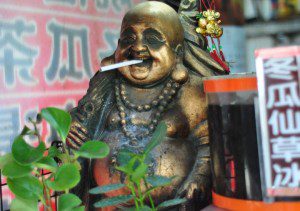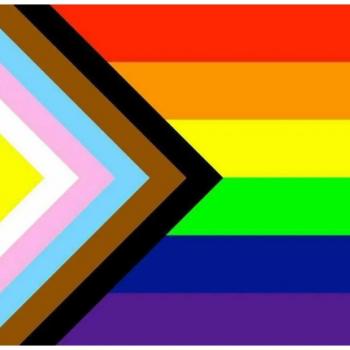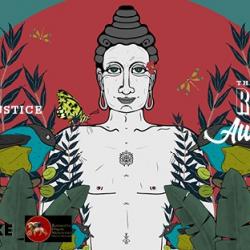Dave Webster, who teaches Religion, Philosophy & Ethics at the University of Gloucestershire is at it again with a new tumblr (interactive-blog-type-thing) dedicated to the often odd (some would say “wrong” or offensive) use of Buddhist images in the West.
Below is my submission (at http://dispirited-dave.tumblr.com/)
I know it’s not exactly from “the West,” but it was the first image that came to my mind, and it seems to follow the spirit of Dave’s tumblr, if not the letter. And perhaps it might disabuse some people of the myth that Asian Buddhists are universally respectful and reverent, etc etc etc*, while modern Western folks are irreverent, disrespectful, syncretic, and so on. But then again, we don’t know enough about it to draw any grand narrative. It’s just a picture. It comes from a souvenir or curio shop (if memory serves me) in a touristy/shopping area north of Taipei, 2010.

From the looks of it, it seemed that a worker or owner had put the cigarette in Maitreya’s mouth. Why? Disrespect? Just having a bit of fun? To attract attention from tourists? I’m not sure.
As I wrote a few months back in “Tantric sex and kissing nuns (Video),” the commodification of Buddhist images is neither terribly new nor restricted to Buddhism, but:
Buddhists, as anyone who reads theworsthorse knows, tend to get portrayed in a positive light in ad campaigns. But, as a small minority religion, Edwards noted, Buddhism gets a disproportionate amount of advertising attention. Buddhism is highly commodified in the West.
* I’ll write more about this down the road, but I worry that there may be a certain amount of what I’ll call ne0-Orientalism in the notion of Buddhist Modernism. This comes in the attempt to portray a clear juxtaposition of ‘traditional’ (Asian) practice and belief and ideas and practices that (must) have been influenced by Western/modern society. Creating this ‘traditional’ image of Buddhism tends to mean overlooking the amazing variety of practices and beliefs in both the history of Buddhism and what might look like a ‘single’ tradition and point in time such as Japanese Zen in the 1980s.











